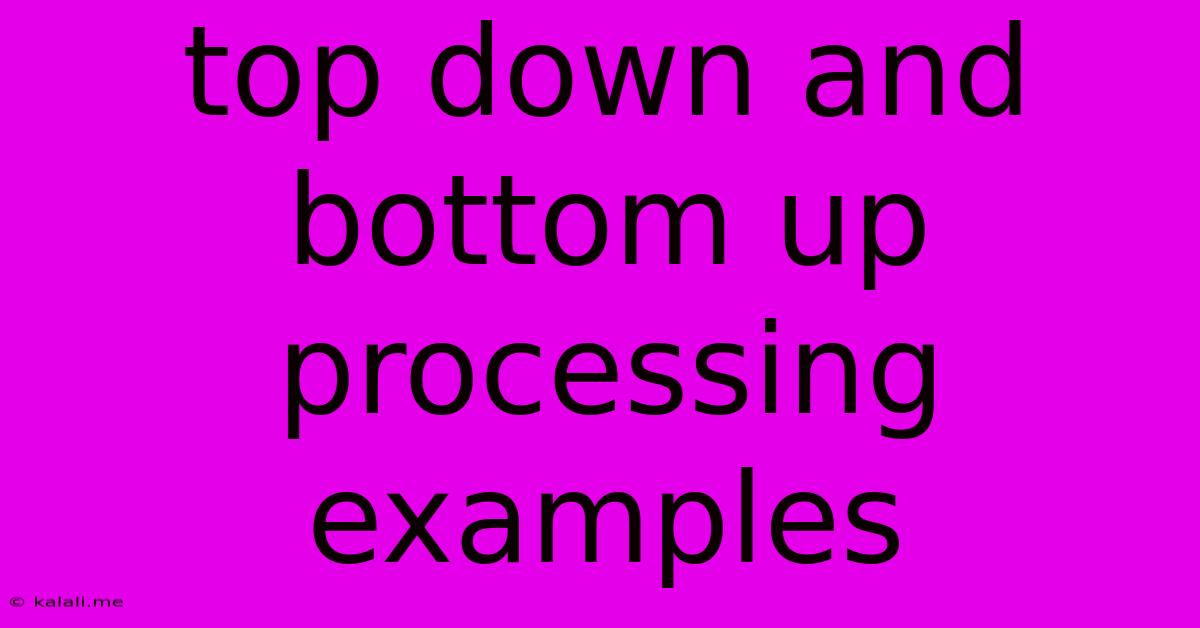Top Down And Bottom Up Processing Examples
Kalali
Jun 08, 2025 · 3 min read

Table of Contents
Top-Down and Bottom-Up Processing: Understanding How We Perceive the World
Our brains are incredible machines, constantly processing information from our senses to create a coherent understanding of the world around us. This process involves two primary approaches: top-down processing and bottom-up processing. Understanding these distinct methods is crucial for comprehending how we perceive, interpret, and interact with our environment. This article will explore both, providing clear examples to illustrate their differences and interplay.
Meta Description: Explore the fascinating world of cognitive psychology with this detailed guide on top-down and bottom-up processing. Learn how these processes shape our perception and understanding of the world through insightful examples.
What is Bottom-Up Processing?
Bottom-up processing, also known as data-driven processing, is a type of information processing that begins with the sensory receptors and works its way up to the brain. It's a fundamental process where our perception is built from the raw sensory data. We start with the individual details and build a bigger picture. Think of it like assembling a jigsaw puzzle: you begin with individual pieces and gradually put them together to reveal the complete image.
Examples of Bottom-Up Processing:
- Recognizing a face: You don't immediately recognize someone; instead, you first process the individual features – eyes, nose, mouth, etc. – and then combine them to identify the person.
- Reading a word: You don't instantly grasp the meaning of a word; your eyes detect individual letters, which are then assembled into words, which are finally interpreted for meaning.
- Feeling a texture: The sensation of touch begins with the receptors in your skin detecting pressure, temperature, and other stimuli. This raw sensory information is then transmitted to the brain to construct the perception of the texture.
- Tasting food: The taste buds detect different chemicals, sending signals to the brain that are then interpreted as sweet, sour, salty, bitter, or umami.
What is Top-Down Processing?
Top-down processing, also called conceptually-driven processing, is the opposite of bottom-up processing. It starts with our prior knowledge, expectations, and context to influence how we interpret sensory information. It's a more interpretive and proactive approach, where our existing knowledge shapes our perception. Imagine you already know what a car looks like; you'll perceive a partially obscured car much more easily than someone with no prior knowledge of cars.
Examples of Top-Down Processing:
- Reading a sentence with a misspelled word: You might still understand the sentence even if a word is misspelled because you use your prior knowledge of language and context to fill in the missing information.
- Recognizing an object partially obscured: If part of an object is hidden, you can still likely identify it based on your prior experience and expectations. For example, recognizing a car even if only a portion is visible.
- Understanding ambiguous images: The famous "old woman/young woman" illusion demonstrates this powerfully. Your interpretation is actively influenced by your initial perception and expectations.
- Listening to a conversation in a noisy environment: You can filter out background noise and focus on the conversation based on your expectations and knowledge of the speaker’s voice.
The Interplay of Top-Down and Bottom-Up Processing
It’s important to note that top-down and bottom-up processing aren't mutually exclusive; they often work together seamlessly. Our perceptions are usually a dynamic interaction between these two processes. For instance, recognizing a friend's face involves bottom-up processing of visual features, but also top-down processing based on your memory and expectations of what your friend looks like. The context of the situation also plays a significant role in how we interpret sensory input.
Understanding these processes provides valuable insight into how our brains construct our reality. By understanding the interplay of top-down and bottom-up processing, we can better appreciate the complexity and efficiency of human perception. This knowledge is valuable in various fields, including design, marketing, and user experience, where understanding how people perceive and interact with information is paramount.
Latest Posts
Latest Posts
-
How To Keep Stink Bugs Away
Jun 08, 2025
-
Not Inherit The Kingdom Of God
Jun 08, 2025
-
How To Remove Mold From Sheetrock
Jun 08, 2025
-
Changing A User Password In Linux
Jun 08, 2025
-
How Long Does It Take For Wheat To Germinate
Jun 08, 2025
Related Post
Thank you for visiting our website which covers about Top Down And Bottom Up Processing Examples . We hope the information provided has been useful to you. Feel free to contact us if you have any questions or need further assistance. See you next time and don't miss to bookmark.